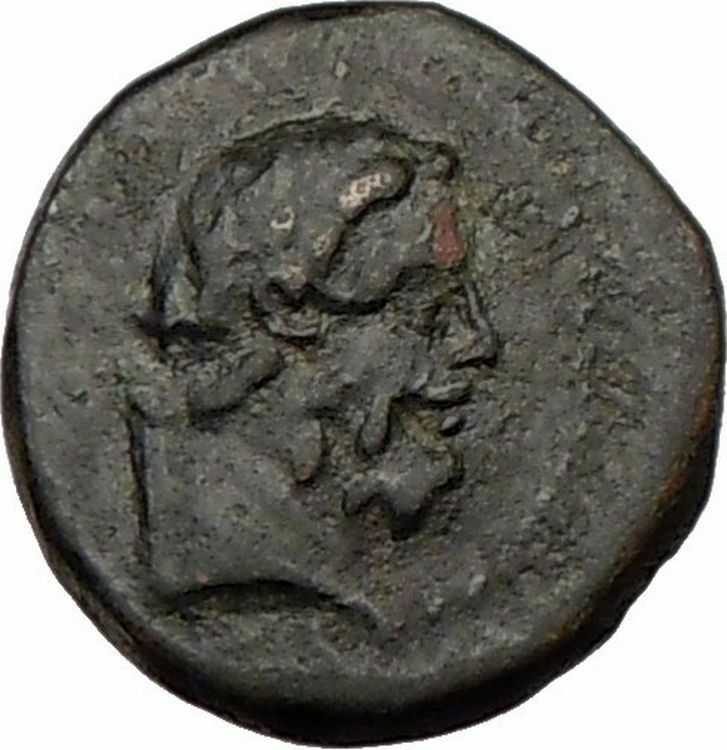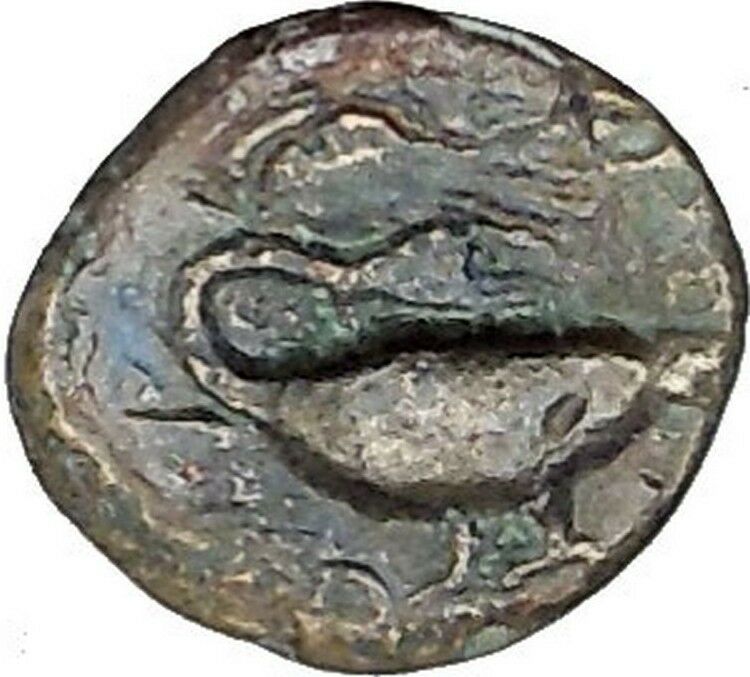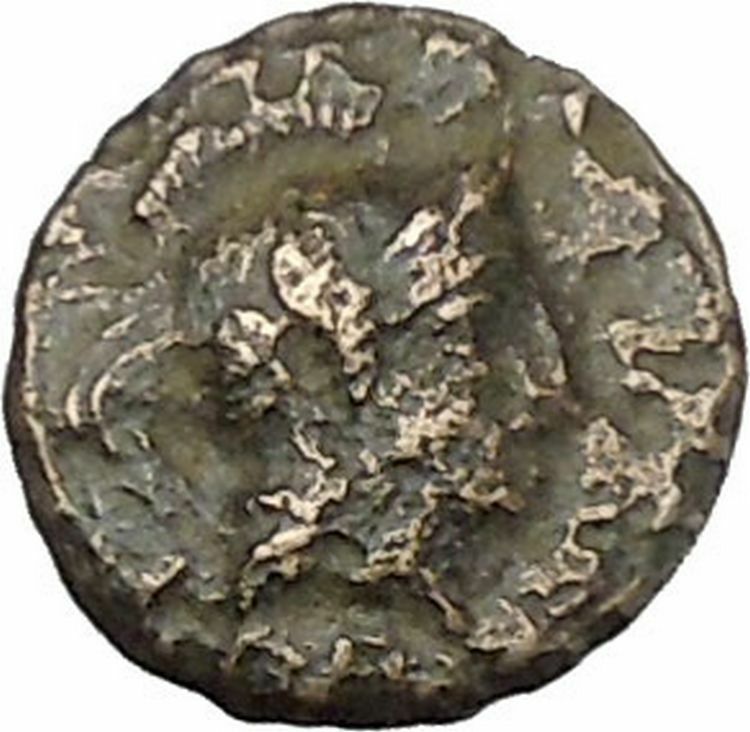|
Greek city of
Athens
in Attica Greece
Bronze 21mm
(8.82 grams) Struck circa 25-19 B.C.
Reference: Kroll 153; SNG Copenhagen
303; Svoronos pl. 80, 18-21
Helmeted head
of
Athena
right.
AΘH,
Sphinx
seated right, wearing modius; all within
olive wreath.
You are bidding on the exact item pictured,
provided with a Certificate of Authenticity and Lifetime Guarantee of
Authenticity.
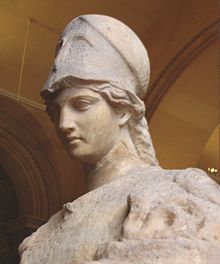
Helmeted Athena with the cista and Erichthonius in his serpent form.
Roman, first century (Louvre
Museum)
In
Greek religion
and
mythology
, Athena or Athene, also
referred to as Pallas Athena/Athene , is the goddess of wisdom, courage,
inspiration, civilization, law and justice, just warfare, mathematics, strength,
strategy, the arts, crafts, and skill.
Minerva
is the
Roman goddess
identified with
Athena.
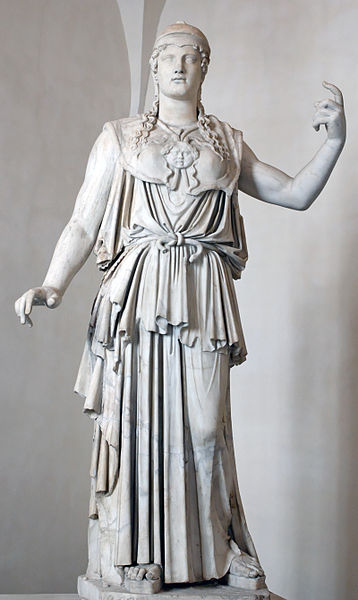
Athena is also a shrewd companion of
heroes and is the
goddess
of heroic endeavour. She is the
virgin
patroness of
Athens
. The Athenians founded the
Parthenon
on the Acropolis of her namesake
city, Athens (Athena Parthenos), in her honour.
Athena’s veneration as the patron of Athens seems to have existed from the
earliest times, and was so persistent that archaic myths about her were recast
to adapt to cultural changes. In her role as a protector of the city (polis),
many people throughout the Greek world worshiped Athena as Athena Polias
(Ἀθηνᾶ Πολιάς “Athena of the city”). The city of
Athens
and the goddess Athena essentially bear
the same name,
“Athenai” meaning “[many] Athenas”.
Patroness
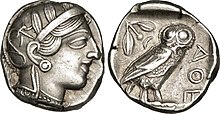
Athenian
tetradrachm
representing the
goddess Athena
Athena as the goddess of philosophy became an aspect of the cult in Classical
Greece during the late 5th century B.C. She is the patroness of various crafts, especially of
weaving
, as Athena Ergane, and was
honored as such at festivals such as
Chalceia
. The metalwork of weapons also fell
under her patronage. She led battles (Athena
Promachos or the warrior maiden Athena Parthenos)
as the disciplined, strategic side of war, in contrast to her brother
Ares, the patron of violence, bloodlust and slaughter—”the raw force
of war”.
Athena’s wisdom includes the cunning intelligence (metis) of such figures
as Odysseus
. Not only was this version of Athena
the opposite of Ares in combat, it was also the polar opposite of the serene
earth goddess version of the deity, Athena Polias.
Athena appears in Greek mythology as the patron and helper of many heroes,
including Odysseus
,
Jason
, and
Heracles
. In
Classical Greek
myths, she never consorts with
a lover, nor does she ever marry,earning the title Athena Parthenos. A remnant of archaic myth depicts her
as the adoptive mother of
Erechtheus
/Erichthonius
through the foiled rape by
Hephaestus
.
Other variants relate that Erichthonius, the serpent that accompanied Athena,
was born to
Gaia
: when the rape failed, the semen landed on
Gaia and impregnated her. After Erechthonius was born, Gaia gave him to Athena.
Though Athena is a goddess of war strategy, she disliked fighting
without
purpose and preferred to use wisdom to settle predicaments.The goddess
only encouraged fighting for a reasonable cause or to resolve
conflict. As patron of Athens she fought in the Trojan war on the side
of the
Achaeans.
Mythology
Lady of Athens
Athena competed with
Poseidon
to be the patron deity of Athens,
which was yet unnamed, in a version of one
founding myth
. They agreed that each would give
the Athenians one gift and that the Athenians would choose the gift they
preferred. Poseidon struck the ground with his
trident
and a salt water spring sprang up; this
gave them a means of trade and water—Athens at its height was a significant sea
power, defeating the
Persian
fleet at the
Battle of Salamis
—but the water was salty and
not very good for drinking.
Athena, however, offered them the first domesticated
olive tree
. The Athenians (or their king,
Cecrops
) accepted the olive tree and with it
the patronage of Athena, for the olive tree brought wood, oil, and food.
Robert Graves
was of the opinion that
“Poseidon’s attempts to take possession of certain cities are political myths”
which reflect the conflict between matriarchal and patriarchal religions.
Other sites of cult
Athena also was the patron goddess of several other Greek cities, notably
Sparta, where the archaic cult of
Athena Alea
had its sanctuaries in the
surrounding villages of
Mantineia
and, notably,
Tegea
. In Sparta itself, the temple of Athena
Khalkíoikos (Athena “of the Brazen House”, often
latinized
as Chalcioecus) was the
grandest and located on the Spartan acropolis; presumably it had a roof of
bronze. The forecourt of the Brazen House was the place where the most solemn
religious functions in Sparta took place.
Tegea was an important religious center of ancient Greece,
containing the Temple of
Athena Alea
. The temenos was founded by
Aleus
,
Pausanias
was informed.
Votive bronzes at the site from the Geometric and Archaic periods take the forms
of horses and deer; there are
sealstone
and
fibulae
. In the Archaic period the nine
villages that underlie Tegea banded together in a
synoecism
to form one city.
Tegea was listed in Homer
‘s
Catalogue of Ships
as one of the cities that
contributed ships and men for the
Achaean assault on Troy
.
Judgment of Paris

Aphrodite is being surveyed by Paris, while Athena (the leftmost
figure) and Hera stand nearby.
El Juicio de Paris
by
Enrique Simonet
, ca. 1904
All the gods and goddesses as well as various mortals were invited to the
marriage of Peleus
and
Thetis
(the eventual parents of
Achilles
). Only
Eris
, goddess of discord, was not invited. She
was annoyed at this, so she arrived with a golden apple inscribed with the word
καλλίστῃ (kallistēi, “for the fairest”), which she threw among the goddesses.
Aphrodite, Hera, and Athena all claimed to be the fairest, and thus the rightful
owner of the apple.
The goddesses chose to place the matter before Zeus, who, not wanting to
favor one of the goddesses, put the choice into the hands of Paris, a
Trojan prince. After bathing in the spring of
Mount Ida
(where Troy was situated), the
goddesses appeared before Paris. The goddesses undressed and presented
themselves to Paris naked, either at his request or for the sake of winning.

Paris is awarding the apple to Aphrodite, while Athena makes a face.
Urteil des Paris by
Anton Raphael Mengs
, ca. 1757
Still, Paris could not decide, as all three were ideally beautiful, so they
resorted to bribes. Hera tried to bribe Paris with control over all
Asia and Europe
, while Athena offered wisdom, fame and
glory in battle, but Aphrodite came forth and whispered to Paris that if he were
to choose her as the fairest he would have the most beautiful mortal woman in
the world as a wife, and he accordingly chose her. This woman was
Helen
, who was, unfortunately for Paris,
already married to King
Menelaus
of
Sparta
. The other two goddesses were enraged by
this and through Helen’s abduction by Paris they brought about the
Trojan War
.

The Parthenon
, Temple of Athena
Parthenos
Masculinity and
feminism
Athena had an “androgynous compromise” that allowed her traits and what she
stood for to be attributed to male and female rulers alike over the course of
history (such as Marie de’ Medici, Anne of Austria, Christina of Sweden, and
Catherine the Great)
J.J. Bachofen advocated that Athena was originally a maternal figure stable
in her security and poise but was caught up and perverted by a patriarchal
society; this was especially the case in Athens. The goddess adapted but could
very easily be seen as a god. He viewed it as “motherless paternity in the place
of fatherless maternity” where once altered, Athena’s character was to be
crystallized as that of a patriarch.
Whereas Bachofen saw the switch to paternity on Athena’s behalf as an
increase of power, Freud on the contrary perceived Athena as an “original mother
goddess divested of her power”. In this interpretation, Athena was demoted to be
only Zeus’s daughter, never allowed the expression of motherhood. Still more
different from Bachofen’s perspective is the lack of role permanency in Freud’s
view: Freud held that time and differing cultures would mold Athena to stand for
what was necessary to them.
Athens
,
the
capital
and largest city of
Greece
,
dominates the
Attica
periphery; as one of the
world’s oldest cities
, its
recorded history
spans around 3,400 years.
The Greek capital has a population of 745,514 (in 2001)
within its administrative limits
and a land area of 39 km2 (15 sq mi).
The urban
area
of Athens extends beyond the administrative
city
limits
with a population of 3,130,841 (in 2001)
and a land area of 412 km2 (159 sq mi).
According to Eurostat
, the Athens
Larger Urban Zone
(LUZ) is the 7th most populous LUZ in the
European Union
(the 5th most populous capital city of the
EU
) with a population of 4,013,368 (in 2004).
A bustling and cosmopolitan metropolis, Athens is central to economic,
financial, industrial, political and cultural life in Greece and it is rated as
an alpha-
world city
.
It is rapidly becoming a leading business centre in the European Union. In 2008,
Athens was ranked the world’s 32nd richest city by purchasing power
and the
25th most expensive
in a UBS
study.
Classical Athens
was a powerful
city-state
.
A centre for the arts, learning and
philosophy
,
home of Plato
‘s
Academy
and
Aristotle
‘s
Lyceum
,
Athens was also the birthplace of
Socrates
,
Pericles
,
Sophocles
and its many other prominent philosophers, writers and politicians of the
ancient world
. It is widely referred to as the
cradle
of Western civilization and the birthplace of
democracy
,
largely due to the impact of its cultural and political achievements during the
5th and 4th centuries BC on the rest of the then known
European continent
.
The heritage of the
classical era
is still evident in the city, represented by a number of
ancient monuments
and works of art, the most famous of all being the
Parthenon
on the
Acropolis
, widely considered a key landmark of early
Western civilization
. The city also retains a vast variety of
Roman
and
Byzantine
monuments, as well as a smaller number of remaining
Ottoman
monuments projecting the city’s long history across the centuries.
Landmarks of the modern era are also present, dating back to 1830 (the
establishment of the independent Greek state), and taking in the
Hellenic Parliament
(19th century) and the Athens Trilogy consisting of the
National Library of Greece
, the
Athens University
and the
Academy of Athens
. Athens was the host city of the
first modern-day Olympic Games
in 1896, and 108 years later it welcomed home
the
2004 Summer Olympics

Acropolis of Athenss
with the
Parthenon
on top.
A sphinx is a
mythical creature
with, as a minimum, the body of a
lion and the head of a human or a cat.
In Greek tradition, it has the haunches of a lion, the wings of a great bird,
and the face of a woman. She is mythicised as treacherous and merciless. Those
who cannot answer her riddle suffer a fate typical in such mythological stories,
as they are killed and eaten by this ravenous monster.[1]
Unlike the Greek sphinx which was a woman, the Egyptian sphinx is typically
shown as a man (an androsphinx). In addition, the Egyptian sphinx was
viewed as benevolent in contrast to the malevolent Greek version and was thought
of as a guardian often flanking the entrances to temples.

In
European decorative art, the sphinx enjoyed a major revival during the
Renaissance
. Later, the sphinx image, something
very similar to the original Ancient Egyptian concept, was exported into many
other cultures, albeit often interpreted quite differently due to translations
of descriptions of the originals and the evolution of the concept in relation to
other cultural traditions.
Generally the role of sphinxes is associated with architectural structures
such as royal tombs or religious temples. The oldest known sphinx was found near
Gobekli Tepe
at another site, Nevali Çori,[2]
or possibly 120 miles to the east at Kortik Tepe,
Turkey
and was dated to 9,500 BC.
Egyptian sphinxes
The sphinx is located in the north and below the pyramids. What names their
builders gave to these
statues
is not known. At the Great Sphinx site,
the inscription on a stele
by
Thutmose IV
in
1400 BCE
, lists the names of three aspects of
the local sun deity of that period,
Khepera
–Rê–Atum.
The inclusion of these figures in tomb and
temple
complexes quickly became traditional and
many pharaohs had their heads carved atop the guardian statues for their tombs
to show their close relationship with the powerful solar deity,
Sekhmet
, a lioness. Other famous Egyptian
sphinxes include one bearing the head of the pharaoh
Hatshepsut
, with her likeness carved in
granite
, which is now in the
Metropolitan Museum of Art
in New York, and the
alabaster
sphinx of Memphis
,
Memphis, Egypt
, currently located within the
open-air museum at that site. The theme was expanded to form great
avenues
of guardian sphinxes lining the
approaches to tombs and temples as well as serving as details atop the posts of
flights of stairs to very grand complexes. Nine hundred with ram heads,
representing Amon
, were built in
Thebes
, where his cult was strongest.
Perhaps the first sphinx in Egypt was one depicting
Queen Hetepheres II
, of the
fourth dynasty
that lasted from
2723
to
2563 BC
. She was one of the longest-lived
members of the royal family of that dynasty.
The largest and most famous is the
Great Sphinx of Giza
, sited at the
Giza Plateau on the west bank of the
Nile River
and facing due east (29°58′31″N
31°08′15″E).
It is also from the same dynasty. Although the date of its construction is
uncertain, the head of the Great Sphinx now is believed to be that of the
pharaoh Khafra
.
The Great Sphinx has become an emblem of Egypt, frequently appearing on its
stamps, coins, and official documents.[4]
Greek traditions
From the Bronze Age
, the Hellenes had trade and cultural
contacts with Egypt. Before the time that
Alexander the Great
occupied Egypt, the Greek
name, sphinx, was already applied to these statues. The historians and
geographers of Greece wrote extensively about Egyptian culture. Heredotus called
the ram-headed sphinxes, criosphinges, and the hawk-headed ones,
hieracosphinges
.
The word sphinx comes from the
Greek
Σφίγξ, apparently from the verb σφίγγω (sphíngō),
meaning “to squeeze”, “to tighten up”.[5][6]
This name may be derived from the fact that the hunters for a pride of lions are
the lionesses, and kill their prey by strangulation, biting the throat of prey
and holding them down until they die. The word
sphincter
derives from the same root.
However, the historian Susan Wise Bauer suggests that the word “sphinx” was
instead, a Greek corruption of the Egyptian name “shesepankh,” which meant
“living image,” and referred rather to the statue of the sphinx, which
was carved out of “living rock” (rock that was present at the construction site,
not harvested and brought from another location), than to the beast itself.[7]
There was a single sphinx in Greek mythology, a unique demon of
destruction and bad luck. According to
Hesiod
, she was a daughter of
Orthus
[8]
and either
Echidna
or the
Chimera
, or perhaps even
Ceto;[9]
according to others, she was a daughter of Echidna and
Typhon
. All of these are
chthonic
figures from the earliest of Greek
myths, before the Olympians ruled the Greek
pantheon
. The Sphinx is called Phix (Φίξ) by
Hesiod
in line 326 of the
Theogony
, the
proper name
for the Sphinx noted by
Pierre Grimal
‘s The Penguin Dictionary of
Classical Mythology.
In
Greek mythology
, a sphinx is represented as a
monster with a head of a woman, the body of a
lioness, the wings of an
eagle
, and a
serpent
headed tail.
The sphinx was the emblem of the ancient city-state of
Chios
, and appeared on seals and the obverse
side of coins from the 6th century BC until the 3rd century AD.
Athena appears in the middle of the upper-half of the middle of a sarcophagus
found in the middle pyramid of Giza, with two sphinxes at her side.

Assyrian
Lamassu
dated 721 BC Institute
Museum, University of Chicago.

Marble Sphinx dated 540 BC Acropolis Museum, Athens
The Riddle of the
Sphinx
The Sphinx is said to have guarded the entrance to the Greek city of Thebes,
and to have asked a riddle of travellers to allow them passage. The exact riddle
asked by the Sphinx was not specified by early tellers of the stories, and was
not standardized as the one given below until late in Greek history.[10]
It was said in late lore that
Hera or Ares
sent the Sphinx from her
Ethiopian
homeland (the Greeks always
remembered the foreign origin of the Sphinx) to
Thebes
in Greece where she asks all passersby
the most famous riddle
in history: “Which creature walks on
four legs in the morning, two legs in the afternoon, and three legs in the
evening?” She strangled and devoured anyone unable to answer.
Oedipus
solved the riddle by answering: Man—who
crawls on all fours as a baby, then walks on two feet as an adult, and then
walks with a cane in old age. By some accounts[11]
(but much more rarely), there was a second riddle: “There are two sisters: one
gives birth to the other and she, in turn, gives birth to the first. Who are the
two sisters?” The answer is “day and night” (both words are feminine in Greek).
Bested at last, the tale continues, the Sphinx then threw herself from her
high rock and died. An alternative version tells that she devoured herself. Thus
Oedipus can be recognized as a “liminal”
or threshold figure, helping effect the transition between the old religious
practices, represented by the death of the Sphinx, and the rise of the new,
Olympian
gods.
In Jean Cocteau
‘s retelling of the Oedipus legend,
The Infernal Machine
, the Sphinx tells
Oedipus the answer to the riddle, to kill herself so that she did not have to
kill anymore, and also to make him love her. He leaves without ever thanking her
for giving him the answer to the riddle. The scene ends when the Sphinx and
Anubis
, who is there to kill the victims who
cannot answer the riddle, ascend back to the heavens.
There are mythic, anthropological, psychoanalytic, and parodic
interpretations of the Riddle of the Sphinx, and of Oedipus’s answer to it.
Numerous riddle books use the Sphinx in their title or illustrations.[12]
|















